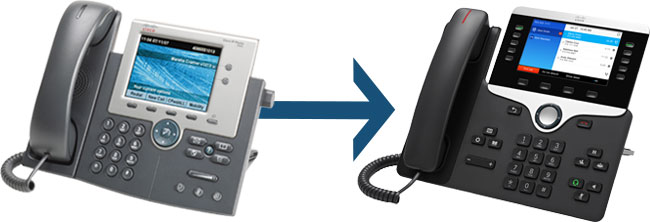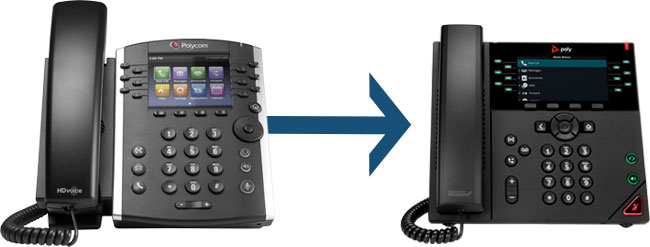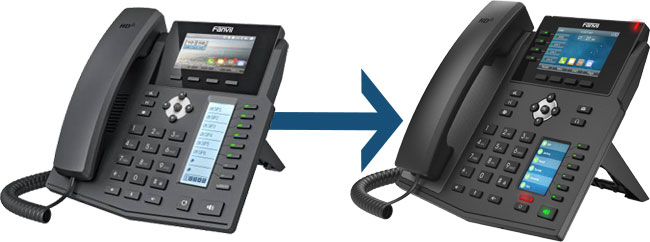Nothing lasts forever. And while VoIP Phones last for a long time — especially when compared with the endless cycle of smartphone upgrades — even your trusty VoIP desk phone will need to be replaced at some point.
But when?
In this blog, we discuss why and when you should upgrade your VoIP phone: what to look out for beyond obvious physical damage or if the phone simply stops working.
Here are reasons why you should replace a VoIP phone:
- End of Life Means No New Firmware Updates
- Why Is Up-to-Date Firmware Important?
- Security Risks from Out-of-Date Firmware
- New Feature Support or Feature Degradation
- No Longer Dealing with Bugs
- Platform Migration
- On-Going Platform Compatibility
- Quality of Life Considerations

End of Life Means No New Firmware Updates
Manufacturers provide firmware to control the fundamental operation of a device. Typically, users never interact with firmware, as compared with “software,” which runs on a more accessible layer of the device’s operation, so you can, for example, manage settings, change your ringtone, and so on.
If the manufacturers are no longer updating your VoIP phones’ firmware, then it’s time to seriously consider replacing your phones.
Look for the terms “EoL” (End of Life) or “EoS” (End of Sale/Service/Support). A company will list a phone as End of Sale at a certain date, meaning that after the current stock runs out, the phone will no longer be sold new officially. The company will then set an End of Support date, typically a few years later, after which the phone will no longer receive firmware updates.
Some companies have convenient pages where they list EoL products and perhaps recommend replacements: for example, Fanvil EoL Products [external link] and Yealink EoL Products [external link].
Some companies will list them by phone series. For example, here’s Cisco’s End-of-Sale and End-of-Life Announcement for the Cisco Unified IP Phones 7945, 7965, 7975 and 7916 [external link]. If you have an older Cisco phone not in this series, it’s worth Googling “cisco (product name) eol” to check out your phone’s status.
Other companies, like Grandstream and Poly, make it a bit more difficult. You’ll have to search by the specific phone model. Here’s a link to the Grandstream Product Archive [external link], which is a good place to start.
(Because of Poly’s acquisition by HP and the ongoing integration of their support pages with the HP Support site, Poly’s support documentation isn’t as thorough as it used to be right now. Hopefully they’ll work it out over time.)
Important: Just because a manufacturer recommends a particular phone as a replacement does not mean that this new phone will be compatible with your VoIP phone system or cloud phone service. Always check compatibility before purchase!
Occasionally, manufacturers will keep the same phone model, but upgrade the phone’s chipset. Sometimes they mark the change with a “V2” or similar to indicate the new version, but sometimes they don’t. The new chipset can affect compatibility and feature support, for example, it might extend the compatible lifetime of the phone. But it does mean there might be multiple versions of the same “phone” out there. Double-check which version specifically you have!
Confused? If you’re having trouble figuring out your phone’s current status, get in touch with us at IP Phone Warehouse! Our experts will help you, including recommending quality replacements that fit your needs and budget.

Why Is Up-to-Date Firmware Important?
Firmware is updated for many reasons, but three are particularly important to this discussion:
- Security Risks from Out-of-Date Firmware
- New Feature Support or Feature Degradation
- No Longer Dealing with Bugs
Security Risks from Out-of-Date Firmware
Operating tech without current firmware updates can lead to security risks. Bad actors are out there: it’s a fact of our technological life. As vulnerabilities are exposed, manufacturers update firmware to fix them. If your firmware is out-of-date, it could mean that aspects of your communications system are exposed — a good argument for upgrading!
New Feature Support or Feature Degradation
Firmware is also updated to improve compatibility with new features. Feature availability on a VoIP phone is determined by the VoIP phone system that you’re using. If your phone system adds a new feature, but your phone’s firmware isn’t updated, it could mean that your phone can’t support the new feature. If you want to ensure access to the latest features, replacing your VoIP phone is a good idea.
On the other side, if the phone system is updated and the phone isn’t, it could lead to feature degradation, where features you rely on no longer work or operate as smoothly anymore. This is particularly important to know if you use a cloud phone service, as those are typically updated more frequently than on-premise phone system.
No Longer Dealing with Bugs
Bugs are an unavoidable aspect of tech. Firmware is updated to fix bugs as they arise. Being without updated firmware means that your phone might not operate optimally, because the manufacturer is no longer squashing bugs. If you find that your phone is experiencing a lot of problems due to bugs, replacing the phone is a good idea.

Platform Migration
If your company is migrating to a new VoIP phone system, you may need to replace your VoIP phones — if your existing phones aren’t compatible with the new system.
As an example, take Microsoft Teams. Part of the Microsoft 365 Suite, Teams has only been a full-fledged phone system for a few years; however, it’s becoming a very popular cloud phone service for the many businesses who seek to simplify their communications infrastructure by going all Microsoft.
Microsoft has a certification program to ensure device compatibility, performance, feature support, and security. If you’d like an in-depth explanation of this, our experts recently wrote a detailed buyer’s guide to Microsoft Teams Phone.
Teams Phone is a desirable service, but your existing phones might not work with it.
This is just one example: compatibility is a primary concern with VoIP phones.
On-Going Platform Compatibility
Even if you’re not migrating to a new system, your phone system might not support your phone model indefinitely. If your phones are getting long in the tooth, it’s worth it to check on your phone system.
Some systems, like RingCentral, will notify you when a phone is End of Support. For example, here’s the Certified and supported deskphones for RingCentral [external link] page, which also lists “Deskphones not supported by RingCentral” and gives you information about “Notifications for end of sale and end of support.”

Quality of Life Considerations
Using a VoIP isn’t just about functionality: it’s also about quality of life. That can mean anything from sound quality to design style to headset compatibility to touchscreen display to Wi-Fi or Bluetooth.
It’s a good thing to have a business device that you feel comfortable with, that you want to use, that you like looking at, and that works how you want your tech to work.
Maybe your old headset’s audio quality isn’t cutting it anymore and you want the simplicity and improved audio quality of a USB headset. Maybe you’re tired of running Ethernet cable to your home office and you want the cleaner, more flexible deployment offered by Wi-Fi.
All these considerations — and many more — are very important to choosing your tech. If your current VoIP phone isn’t working for you, it may be time for an upgrade.

